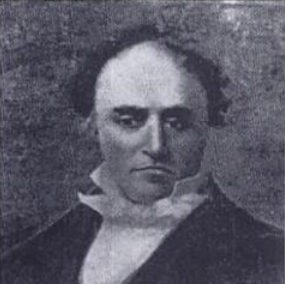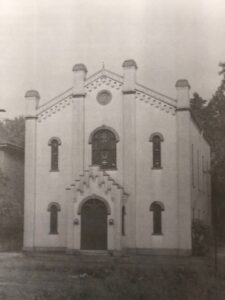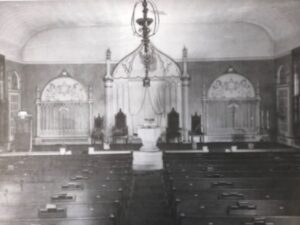Temple Israel has a long history in the Greater Lafayette Area and is proud to be a part of the sacred Jewish history of this community.
Jewish pioneers were a part of the early history of Indiana long before its statehood in 1816. The Illinois and the Wabash Land Company organized by 1775, induced many a lover of liberty to seek a new territory that promised freedom of conscience and the “inalienable rights of life, liberty, and the pursuit of happiness.
The Early Jewish Settlers in Indiana

By the end of the first quarter of the 19th century, the names of Baruch Hays, his son Jacob Hays, and Samuel B. Judah were already woven into the state history. Lieutenant Baruch Hays served in the Revolutionary War and was a member of one of the oldest American Jewish families in the East. John Hays entered the Indian trade at a young age. In 1822 in Fort Wayne, he acted as Indian agent for the Potawatomi and Miami tribes. He was also the first Jewish person to settle in what is now Illinois in 1793. Barrister Judah was the first Jewish graduate from Rutgers Law School in 1816. He served as a representative in the Indiana House of Representatives and participated in the peacetime building of the new state, in such towns as Fort Wayne and Vincennes, where he lived.
The site of Lafayette, at the head of navigation on the Wabash River on the line of the Wabash and Erie Canal, began about 1825 and assumed an important place in the commerce between the East and the growing West. Lafayette soon earned the title of the “Star City of the West,” as early historians invariably described the thriving river community.
German Jewish Settlers to Lafayette
After 1820, waves of immigrants from Europe populated Indiana. The first wave consisted primarily of German-speaking Jews from central Europe who left Germany for better economic lives and the discrimination and inequality they experienced at the behest of German society.
In the mid-1840s, three brothers of a German Jewish family named Kuhn settled in Lafayette. Abraham, Samuel, and Max Kuhn were established by 1849. Abraham Kuhn later left Lafayette to become the co-founder of the famous banking house of Kuhn, Loeb & Company in New York City. His brother, Max, died at the comparatively early age of 28 in 1851, and his grave was one of the first to be dug in the small Jewish cemetery, which the new congregation had only recently acquired.
By 1849 approximately 20 Jewish families had settled in Lafayette, and they expressed a two-fold need—an association for the regular worship of Almighty God and a burial place for the reverent internment of their departed ones in consecrated soil. During that spring, one among them died, and it became clear that the families urgently needed to own their own Jewish burial plot.
The two projects were carried out almost simultaneously. On April 27, 1849, the families formed an association known as “Ahavas Achim” (brotherly love). Its first action was to appoint a committee of three to serve as trustees in investigating and purchasing a site for a cemetery. On November 19, that year, Trustees Martin Hollstein, Moses Amberg, and Abraham Joel purchased from Owen and Peter Ball the tract of land off South Fourth Street, which became “The Hebrew Burial Ground of Tippecanoe County.” With the possession of this communal spot, the Jewish people began a history of spiritual unity and the fellowship of brotherly love that expressed itself in the regular observance of their religious tradition in the new land.
Our Timeline

Circa 1840 – First Jewish families settle in Tippecanoe County
April 27th, 1849 – Jewish families form association known as “Ahavath Achim,” the second oldest congregation in Indiana, which worshipped in various homes and buildings
November 19th, 1849 – Land is purchased for what came to be known as “The Hebrew Burial Ground of Tippecanoe County”
December 20th, 1866 – A congregational building committee is formed
High Holy Days 1867 – First Synagogue built at 7th and Alabama St and dedicated by Isaac M. Wise.
June 25th, 1874 – Ahavath Achim joins the Union of American Hebrew Congregations (UAHC) adopting Reform Judaism.
Circa 1889 – Sons of Abraham (a conservative synagogue) is founded in response to Ahavath Achim’s Reform Practice
April 28th, 1899 – Golden Anniversary Services: 50 year celebration of the congregation’s existence
November 2, 1917 – 50th anniversary celebration of the dedication of the synagogue building on 7th and Alabama.
1919 – Ahavath Achim changes its name to Temple Israel
May 12th, 1949 – Temple Israel celebrates 100 years of existence
March 20th, 1964 – a new building site is chosen in West Lafayette
August 1, 1969 – Temple Israel celebrates its last Shabbat at 7th and Alabama.
September 5, 1969 – Temple Israel holds first service in new West Lafayette building
April 1973- Linda Cohen is elected as the 123rd Temple President and the first woman temple president
1991 – Temple Israel welcomes resettled Russian Jewish families after the fall of the Soviet Union
2006 – The West Lafayette Temple Israel building is expanded and renovated

Interior of the original Ahavath Achim Synagogue
The Rabbis of Temple Israel
| J. Sutman | 1851-1854 |
| Elijah B. Schoenfeld | 1854-1855 |
| B. Goodman | 1855-1856 |
| N. Emmich | 1856-1857 |
| H. Loventhall | 1858-1860 |
| Joseph Solomon | 1860-1864 |
| J. Schaffner | 1864-1865 |
| Milton Weill | 1867-1868 |
| Isaiah Fall | 1868-1874 |
| Marcus Bonheim | 1874-1879 |
| L. Freudenthal | 1879-1883 |
| Rev. Zeisler | 1883-1884 |
| Jacob Cadden | 1897-1898 |
| Frederick Cohn | 1898-1899 |
| Joseph Leiser | 1899-1901 |
| Morris M. Feuerlicht | 1901-1904 |
| Julian Morgenstern | 1904-1907 |
| Nathan Krass | 1907-1908 |
| Horace J. Wolf | 1908-1909 |
| Arthur A. Zinkin | 1909-1915 |
| Hyman B. Cantor | 1915-1916 |
| Maxwell Silver | 1916-1918 |
| Carl Schorr | 1918-1919 |
| Samuel Harris | 1919-1922 |
| Harry N. Caplan | 1922 |
| Samuel H. Markowitz | 1922-1924 |
| Arthur Feldman | 1924-1926 |
| Bernard J. Bamberger | 1926-1929 |
| Jacob Krohngold | 1929-1930 |
| Meyer H. Simon | 1934-1949 |
| Jacob L. Halevi | 1949-1950 |
| Milton Richman | 1950-1951 |
| Rav A. Soloff | 1951-1952 |
| Milton Richman | 1952-1955 |
| N. William Schwartz | 1955-1961 |
| Joseph Liberles | 1961-1963 |
| Stephen E Weisberg | 1963-1966 |
| Burton E. Levinson | 1966-1982 |
| Ben A. Romer | 1982-1987 |
| Samuel I. Weingart | 1987-2002 |
| Audrey Pollack | 2002-2015 |
| Phil Cohen | 2015-2017 |
| Michael Harvey | 2017-2020 |
| Karen Fanwick | 2020-2022 |
| Adam Bellows | 2022- |